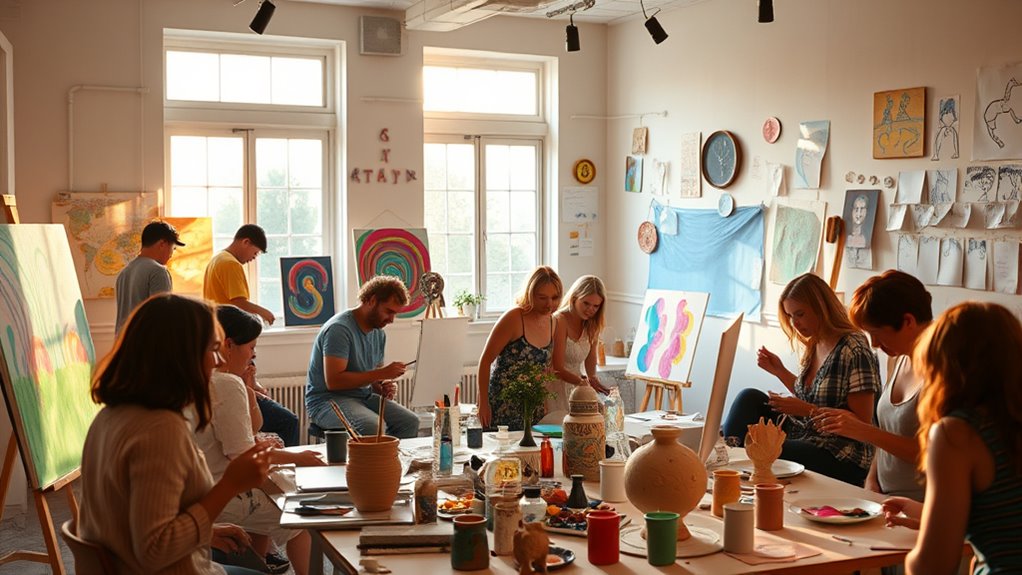Art therapy combines creative expression and color symbolism to help you process trauma and access deep emotions. By engaging in art without needing artistic skill, you can explore feelings and memories in a safe space. The use of symbolic colors and shapes encourages self-awareness, emotional release, and personal growth. As you focus on the process, you’ll uncover insights that promote healing and resilience. Continue exploring, and you’ll discover more about how art can transform your journey.
Key Takeaways
- Art therapy facilitates emotional expression and processing of trauma through symbolic use of color and form.
- The creative process helps bypass the mind’s defenses, revealing subconscious feelings related to trauma.
- Using color symbolism allows individuals to communicate complex emotions difficult to express verbally.
- Engaging in art promotes self-awareness, emotional release, and personal growth in a safe, supportive environment.
- Artistic exploration enables trauma survivors to reclaim their voice and foster healing through authentic self-expression.

Art therapy is a powerful approach that combines creative expression with mental health support. It allows you to explore your feelings, memories, and experiences through the process of making art. When you engage in art therapy, you’re not just creating images; you’re tapping into the symbolic language of color and form, which can reveal emotions that words often can’t express. Color symbolism plays a significant role here, as different hues carry specific meanings and can help you access subconscious thoughts. For example, using red might symbolize passion or anger, while blue can evoke calmness or sadness. By intentionally choosing colors, you communicate feelings that might be difficult to articulate verbally, making your creative expression a crucial tool for healing.
Art therapy uses color symbolism to reveal and express deep emotions beyond words.
As you work through your art, you gain insight into your emotional landscape without judgment. This form of expression bypasses the analytical mind, allowing your subconscious to guide your creative process. You may find yourself using bold, aggressive strokes when feeling frustrated or gentle, soothing colors when seeking comfort. The act of creating becomes a dialogue with yourself, helping you process complex emotions related to trauma or stress. Over time, this ongoing dialogue fosters self-awareness and emotional resilience. You start recognizing patterns in your artwork that reflect underlying issues, giving you an opportunity to confront and work through them in a safe, supportive environment.
The beauty of creative expression in art therapy is that it doesn’t require any artistic skill. Your focus is on what the process reveals rather than on producing a perfect piece. This liberates you from the fear of judgment and encourages honest exploration. As you experiment with different media—paints, crayons, collage—you develop a deeper understanding of your inner world. Sometimes, the act of choosing specific colors or shapes can be a symbolic gesture, representing a desire for change or a need for release. This symbolic language helps you communicate complex feelings that are hard to put into words, making your artwork a powerful form of self-expression and healing. Additionally, understanding how legislative changes influence access to mental health support can empower you to seek appropriate resources when needed.
Ultimately, art therapy harnesses the power of creative expression and color symbolism to facilitate emotional release and growth. It provides a safe space where you can confront trauma, process difficult feelings, and find a sense of peace. Through your art, you reclaim your voice and discover new ways to understand yourself. This journey of healing isn’t about creating a masterpiece but about engaging authentically with your inner world and nurturing emotional well-being through the transformative power of art.
Frequently Asked Questions
Can Art Therapy Help With Severe Mental Health Disorders?
Yes, art therapy can help with severe mental health disorders. Its effectiveness has been demonstrated in improving mental health by providing a safe outlet for emotions and fostering self-awareness. You might find that engaging in creative activities helps you process complex feelings, reduce anxiety, and improve overall mental well-being. While it’s not a standalone solution, art therapy often complements other treatments, contributing markedly to mental health improvement.
How Long Does It Typically Take to See Results in Art Therapy?
You can expect to see results in art therapy within a few sessions to several months, depending on your goals and engagement. Typically, the duration expectations vary, but consistent participation accelerates progress indicators, such as increased emotional awareness and reduced distress. As you create and reflect, you’ll notice changes, like clearer insights and emotional relief, shaping your healing journey. Patience and openness are key to truly experiencing art therapy’s transformative power.
Is Art Therapy Effective for Children and Adolescents?
Yes, art therapy is effective for children and adolescents. You’ll notice increased child engagement as they express emotions through creative activities, helping them process feelings in a safe space. This approach encourages emotional expression, making it easier for young clients to share their experiences. With consistent sessions, many children experience improved emotional well-being, confidence, and resilience, making art therapy a beneficial tool for supporting their mental health and development.
Do You Need to Be Artistic to Benefit From Art Therapy?
You don’t need to be artistically talented to benefit from art therapy. Artistic ability isn’t the goal; it’s about revealing your inner voice through creative expression. This process helps you explore feelings and experiences without judgment. Art therapy welcomes everyone, regardless of skill level, because it’s the act of creating that matters most. So, don’t worry about being “artsy” — your personal journey and expression are what truly count.
Are There Any Risks or Downsides to Art Therapy?
You might encounter risks with art therapy, such as emotional triggers that bring up difficult feelings or memories. If you’re concerned about artistic limitations, remember that you don’t need to be highly skilled to benefit; the process is more about expression than perfection. However, if certain images or themes cause distress, discuss these with your therapist to guarantee a safe, supportive environment for healing.
Conclusion
As you embrace art therapy, you open a door to healing that’s as gentle as a sunrise after darkness. Your creativity becomes a bridge, guiding you across turbulent waters toward inner peace. Remember, each brushstroke or clay shape is a step forward on your journey, transforming pain into power. By trusting this process, you craft a new narrative—one where healing blooms from the very colors and forms you create.










